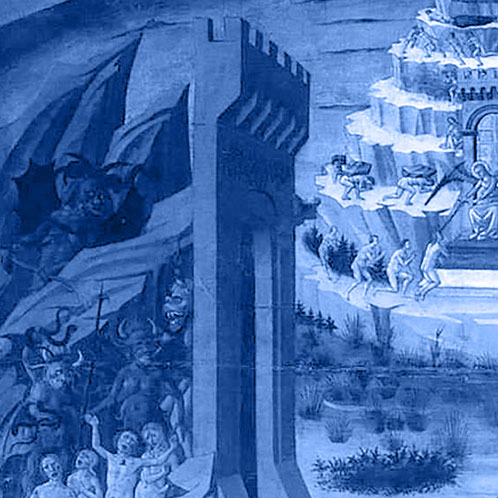Inferno
Informal Prompts
- One major debate in Dante’s period was whether people who lived outside Christendom, or in a time before Christ, were still condemned to hell as nonbelievers. Do you think it is fair to hold someone accountable to a rule they are unaware of? If you were present during these debates, what would you argue?
- Visions of the afterlife often imply some sort of commentary on the current world. Pick a religious tradition you know something about. How does its vision of the afterlife imply judgements about what’s “right” and “wrong” in the present world?
- One reason the Inferno is fascinating is the intricacy and creativity of its punishments. Why are we seduced by reading about grotesque things? Is the appeal of Inferno similar to that of horror movies like Saw?
- For Dante, sin isn’t simply a matter of good-versus-evil. Instead, he thinks one sins when one strays from a “golden mean” between two principles, doing more of one than the other in an unbalanced way. (For example, in Canto 5 the Lustful are not just those who desired, but those who let their desire overpower their reason.) What kind of ethics do you have? Are there absolute goods and absolute evils in the world? Or are most things good in moderation, but bad in excess? Or some combination?
- One thing that makes the Inferno remarkable is that Dante is incorporating figures from all world religions in his narrative, and not always in a condemnatory fashion. This in turn reflects the growing awareness in Dante’s time of the diversity of cultures and beliefs around the globe. Do you think religions are mutually exclusive, or complementary? Do they imply that one is right and the others wrong, or do they complement each other in some way?
Short Answer / Critical Response
Dante puts many present-day figures from his own time in hell, as implicit condemnation of their sinful acts. Why does Dante critique these figures through an elaborate poem about hell, rather than simply writing a public essay denouncing them? How is his critique of present-day figures made stronger or more compelling by casting it in the narrative of the Inferno?
Sometimes Dante’s hell reads like an issue of People magazine, with guest appearances by great historical figures. Why do some figures wish to be remembered by people on Earth, while others wish to be forgotten? What does this difference imply about the relative severity of their sins?
In Canto 13, Suicides and Squanderers are transformed into trees and torn apart by dogs. What do these sins consist of, what punishments are meted out to them, and how are these punishments designed to fit the character of the “crime”?
Do a 2-column comparison chart between the portrayal of Beatrice in Cantos 1 and 2, and that of Penelope in the Odyssey. Are they active or passive figures? What roles do they play in moving the story along? Highlight any other similarities or differences that jump out at you.
Pick one type of sin, and design a circle of hell for it using Dante’s system of “counter-penalties,” in which the punishment fits the crime. How will the system of punishments work in your circle of hell, and who will you put there?
Essay Prompts
Pick one of the following Cantos—5, 13, 15, 26 or 33—and conduct a close reading of it. How does your canto offer an implicit commentary on the contemporary world? Analyze how the sins defined and punishments designed, what sort of historical, non-Western, or political figures are included, and how Dante incorporates these into his narrative.
There have been many great pictorial representations of Dante’s Inferno. Take a look at some of the works on Digital Dante, and then design your own system of hells with 9 circles. Now write a ##-page accompanying essay, outlining the organization of your inferno, the sins you focused on, the ways punishments fit these crimes, and what historical or contemporary figures you would put in each.


This entry is licensed under a Creative Commons Attribution-NonCommercial-ShareAlike 4.0 International license.


